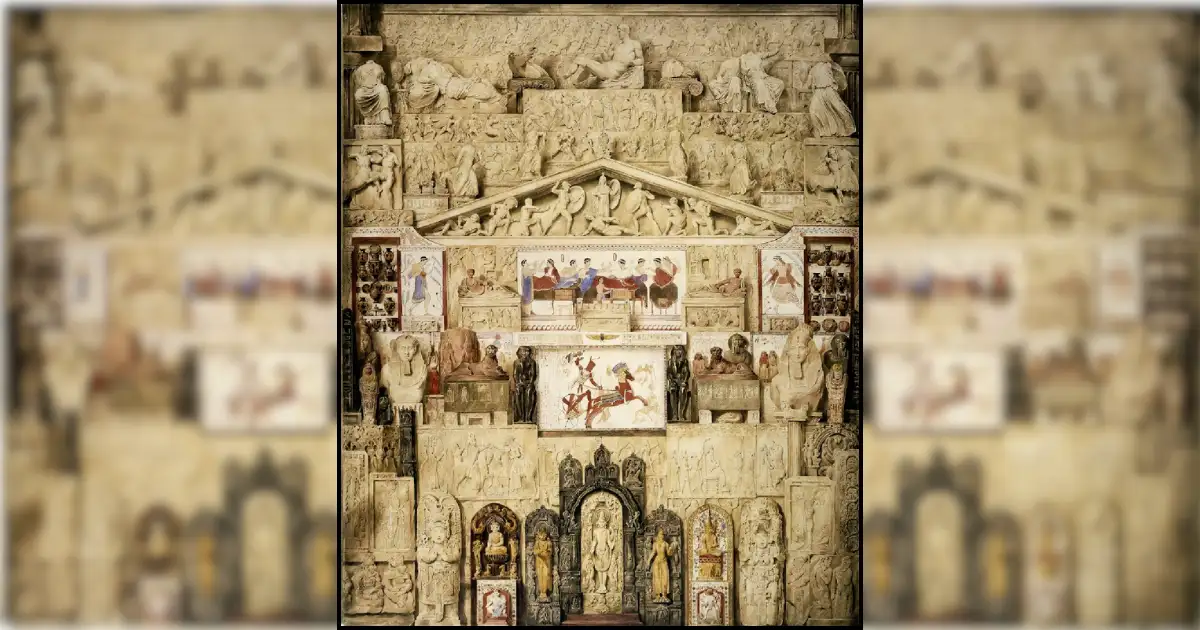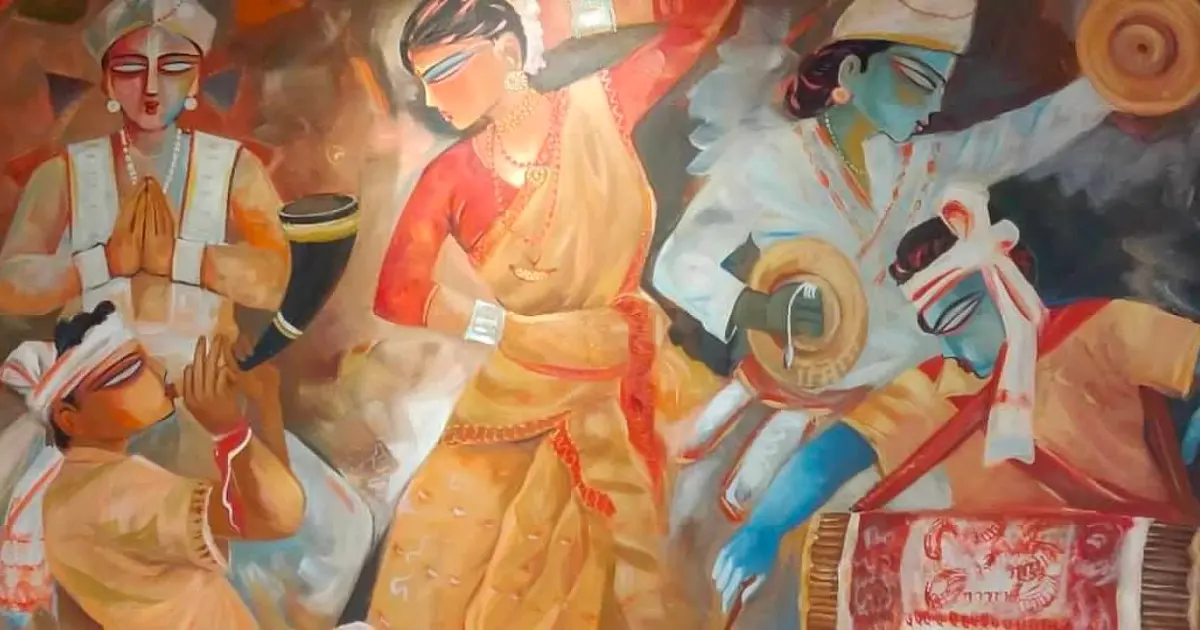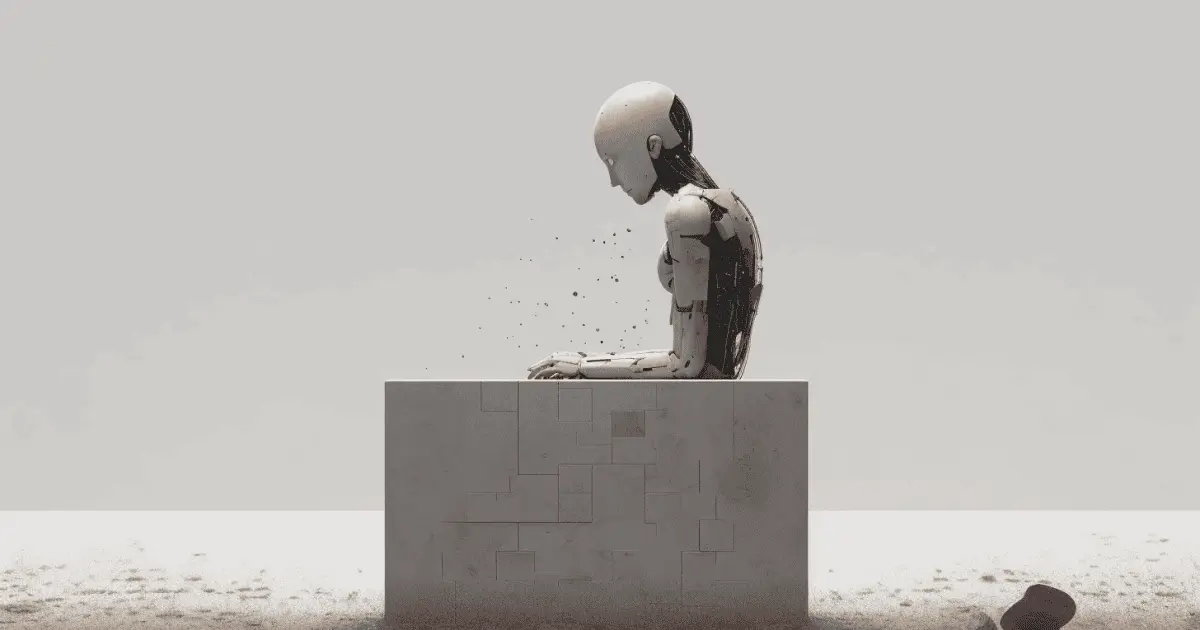What do we see when we look at James Stephanoff’s An Assemblage of Works of Art (circa 1845)? At first glance, it appears to be a grand visual celebration of global artistic heritage. A kaleidoscopic collection of sculpture and design from across time and space. A democratic assemblage of human creativity.
But look closer. This is not a collage. It is a civilizational script. A carefully composed visual grammar of hierarchy, one that reflects the intellectual architecture of European imperialism. Stephanoff’s wall is not neutral. It is pedagogical. It does not merely display artworks. It teaches us how to see them. It orders civilizations not by geography or chronology, but by proximity to the imagined ideal of Europe.
At the summit of this tableau are Greco-Roman sculptures, cast in gleaming white marble. They represent, in the 19th-century European imagination, the apex of beauty, symmetry, rationality, and reason. They are not just artistic forms. They are emblems of the Enlightenment's self-conception. Greece and Rome were imagined as the intellectual ancestors of modern Europe, and so their artefacts were placed at the pinnacle.
Below them, almost buried in shadow, are sculptures from the Indian subcontinent: Hindu mūrtis, Buddhist icons, Jain tirthankaras. They are accompanied by the symbolic systems of Mesoamerica, the divine iconography of Egypt, and the ritual forms of Africa. These works are not ignored entirely. They are present, but peripheral. They are included, but never as equals. Their placement at the margins is not accidental. It reflects a civilizational worldview in which these cultures were seen as spiritually rich but intellectually inferior. They are made into the ancient “Other.”
This arrangement is not simply aesthetic. It is deeply political.
Museums as Civilizational Machines
Tony Bennett in The Birth of the Museum argues that museums were central to the emergence of modern forms of governance. They did not just collect. They ordered. They turned the globe into a manageable archive.
European empires, as both conquerors and curators, transformed stolen objects into pedagogical exhibits.
The British Museum, established in 1753, set the precedent. What began as a cabinet of curiosities evolved into a structure that classified the world’s knowledge into tiers. Ashmolean Museum in Oxford and the Louvre in Paris followed similar patterns. The logic of display was civilizational: Europe at the center, others as tributaries.
Objects were extracted from living traditions, stripped of their ritual and cosmological significance, and inserted into foreign taxonomies. The Dancing Śiva, for instance, became a Hindu idol rather than Naṭarāja, the cosmic dancer embodying the cycle of creation and dissolution. The Benin Bronzes were displayed for their technical finesse but divorced from the royal rituals of the Kingdom of Benin.
This process is what Gayatri Chakravorty Spivak calls epistemic violence. The violence lies not just in the looting but in the reinterpretation, in the forcing of indigenous artefacts into alien frames of reference. It is the replacement of plural cosmologies with a singular, universalizing gaze.
Aesthetic Politeness and Epistemic Hierarchies
Stephanoff’s wall reflects what Walter Mignolo refers to as the colonial matrix of power: a system that simultaneously extracts material wealth and reorganizes knowledge. The arrangement on the wall naturalizes the assumption that Europe is the measure of all things.
This assumption survives in academic canons. Non-Western philosophies are often relegated to optional courses or elective modules. Hindu, Buddhist, and African epistemologies are studied not for their ontological claims but for their exoticism or spiritual flavor. When taught, they are often mediated through Western categories - religion, myth, mysticism - that distort their internal logic.
For instance, the Indian tradition of Darśana is translated as philosophy, though it is equally a way of seeing and being. The Nāṭyaśāstra is labeled as an aesthetic manual, though it is a cosmological and performative framework. The African concept of Ubuntu is reduced to a soft moral code rather than a relational metaphysics of selfhood.
Even in contemporary museum labels, these hierarchies persist. The British Museum describes Apollo as a “god of reason” while referring to Kālī as a “terrifying figure in Hindu mythology.” The Greek pantheon is intellectualized. The Hindu pantheon is spiritualized. The same structures of classification survive in new guises.
From Knowledge to Extraction
This epistemic violence is not confined to academia. It seeps into popular culture. Indian yoga becomes a posture practice, stripped of its yamas, niyamas, and spiritual discipline. Āyurveda is rebranded as “alternative medicine,” rather than a system of ecological and ethical balance. Buddhism is commodified into “mindfulness” apps that remove suffering, supposedly distilled from the Four Noble Truths.
What remains is the surface, not the substance. Aesthetic forms are celebrated. The worldviews beneath them are denied.
This is a form of epistemic extraction. The philosophical, ethical, and metaphysical frameworks of the non-West are mined for aesthetic and commercial value, but rarely recognized as knowledge systems in their own right. This is what historian Michel-Rolph Trouillot called “the silencing of the past.” The theft is not just of objects but of meaning.
What If the Wall Was Reimagined?
What if the starting point was not classical antiquity, but metaphysical plurality? What if we began with the ṛta of the Vedas, the harmony of the Tao, the balance of maat in Egyptian philosophy, or the cyclicality of time in Mesoamerican cosmology?
What if the gallery did not arrange cultures in a line of ascent culminating in Europe, but embraced a mandala logic, where the center held many centers? What if the criteria for inclusion were not stylistic affinity to Europe but the ontological and cosmological richness of the traditions themselves?
Museums like the Zhiwu Yuan in China or the Mapungubwe Heritage Centre in South Africa have attempted such reimaginings. Some institutions in India, like the Indira Gandhi National Centre for the Arts (IGNCA), try to present knowledge systems alongside artefacts. But the dominant model remains Stephanoff’s wall: civilizational ranking masked as aesthetic celebration.
Beyond Provincial Universals
Dipesh Chakrabarty’s call to provincialize Europe reminds us that categories like art, reason, secularism, and beauty are not universal. They are historically and culturally specific. The challenge is not to replace Western knowledge but to dislodge its monopoly.
We must cultivate an academic and curatorial ethic that begins not with assimilation but with translation. Not with inclusion but with epistemic humility.
The answer is not to simply add more diversity to the wall. It is to question the wall itself.
Conclusion: The Wall Is Still Standing
Stephanoff’s wall belongs to the 19th century, but its logic is alive today. It survives in school textbooks, university syllabi, heritage sites, and even Instagram captions. It teaches us who counts as knowledge and who as ornament.
To look at the wall critically is to understand that the politics of beauty is the politics of empire. But to imagine a new wall, or to do away with the wall altogether, is to begin the work of decolonizing the eye, the museum, and the mind.
As long as the wall continues to frame the world through civilizational hierarchies, the task of rethinking it remains not just desirable, but necessary.
References
- Bennett, T. (1995). The Birth of the Museum: History, Theory, Politics. Routledge.
- Chakrabarty, D. (2000). Provincializing Europe: Postcolonial Thought and Historical Difference. Princeton University Press.
- Spivak, G. C. (1988). Can the Subaltern Speak? in Marxism and the Interpretation of Culture.
- Mignolo, W. D. (2011). The Darker Side of Western Modernity. Duke University Press.
- Trouillot, M.-R. (1995). Silencing the Past: Power and the Production of History. Beacon Press.
- Coombes, A. E. (1994). Reinventing Africa: Museums, Material Culture and Popular Imagination. Yale University Press.
- Ziff, B., & Rao, P. V. (Eds.). (1997). Borrowed Power: Essays on Cultural Appropriation. Rutgers University Press.
- Bhabha, H. K. (1994). The Location of Culture. Routledge.
- Mudimbe, V. Y. (1988). The Invention of Africa. Indiana University Press.





